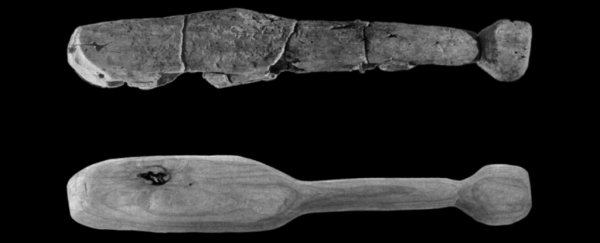Humans have lived around the River Thames in England for millennia, which means the river foreshore is surprisingly rich in archaeological artefacts. One such item is the Thames Beater, excavated from peat deposits in Chelsea in the 1990s.
It's a wooden object, dating back to the Neolithic, around 3630-3350 BCE. It resembles a cricket bat: a wide paddle, a narrow shank for a handle, and a pommel. But its purpose was a bit more belligerent than cricket - it was a weapon.
Scientists have been wondering how lethal it would have been; now, according to a new experiment, we have gruesome results - the Beater could have killed a human with a single blow.
Many human skeletons from prehistory show evidence of blunt force trauma, but it's not always easy to tell exactly how these injuries were sustained, whether they were accidental or the result of violence. But if we can determine how an injury occurred, that can tell us about interpersonal violence in prehistoric societies.
The in situ context of the bones can sometimes give clues as to an injury's provenance, such as a battlefield with many injured bodies and weapons; and comparison with modern injuries.
Wooden weapons present even more of a problem, because wood decays. Very few wooden clubs from the Neolithic have survived to the present day, so the Thames Beater presents a rare opportunity.
 (Meaghan Dyer)
(Meaghan Dyer)
Previously, tests of blunt force trauma have often used human cadavers or animals, but there are issues surrounding accuracy, availability, and ethics. But recently developed materials mean that we no long have to rely on the real thing.
Instead, scientists can build an accurate simulation of the human head.
This is what a team of researchers from the University of Edinburgh led by Meaghan Dyer of the School of Archaeology has done.
Their head uses a variety of materials to simulate skin, skull and brain. The four "skulls" were made of a specialised polyurethane material created to mimic the properties of bone.
This was coated with a rubber material to simulate skin, and filled with ballistics gelatin to represent brain matter, because an unfilled sphere won't fracture in the same way as a (full) human skull.
The researchers then recruited a master carpenter to build a replica of the club. The replica was made of alder wood, just like the original. This is so that the replica could be as close as possible to the weight, strength and physical properties of the original.
For the final step, a strong 30-year old man was recruited to bash the 1.2-kilogram (2.6-pound) weapon into the skulls as hard as he could, using the club for two strikes and the pommel for two. (Sadly, we couldn't find a video of this action.)
The club fractures were almost identical to a skull found at a Neolithic site in Austria determined to have been one of violent conflict.
 (Meaghan Dyer)
(Meaghan Dyer)
"The depression fractures formed by the double-handed blade strikes to the skin-skull-brain models bear a significant resemblance to examples of violence-related blunt force trauma in the Neolithic osteological record," the researchers wrote in their paper.
"The fracture morphology, shape of displaced fragments and the bevelled fracture edges produced in both spheres very closely match trauma linked to wooden clubs."
This supports the hypothesis that wooden clubs were used as a lethal weapon during the Neolithic; however, the paper notes, more research is required to find out if clubs of this kind could have produced healed injuries found in Neolithic skeletons.
The team is also conducting research on other weapons to see if they can be matched with other types of injuries found in Neolithic bones.
The paper has been published in the journal Antiquity.
